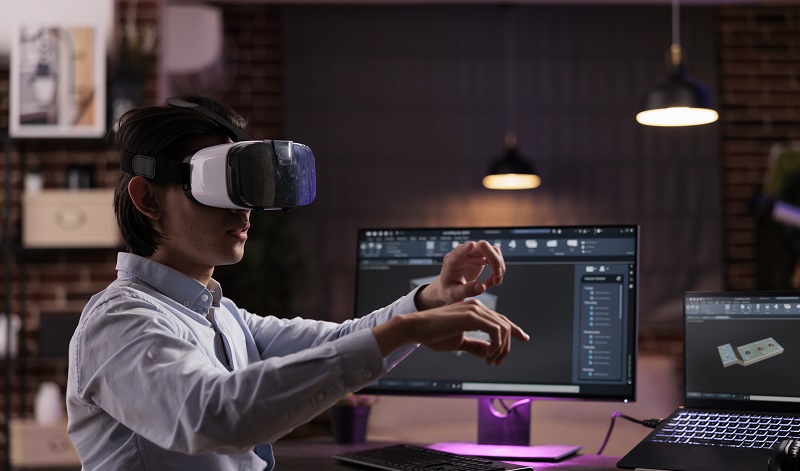
Metaverse Graphics: Designing for Immersive Virtual Worlds
The metaverse is no longer a concept from science fiction but a rapidly emerging digital reality. As technology advances and our online experiences become increasingly immersive, the role of metaverse graphics in shaping these virtual worlds has never been more crucial. In this blog post, we’ll explore the importance of metaverse graphics and how designers are creating captivating and immersive environments for the metaverse.
The Metaverse: A New Digital Frontier
The metaverse is a collective virtual shared space, merging augmented reality (AR), virtual reality (VR), and other immersive technologies. It is where users can interact with each other and digital objects, often in real time. The metaverse represents a new dimension for social interactions, entertainment, education, work, and more. It’s a space where imagination knows no bounds.
Metaverse Graphics: Designing the World
In the metaverse, the visual experience is paramount. It’s not just about what you see; it’s about how you feel while navigating these immersive digital environments. Metaverse graphics encompass a range of design elements, from 3D modeling and texturing to lighting, sound, and animation, all tailored to create a seamless, immersive world.
3D Modeling and Texturing: One of the foundations of metaverse graphics is 3D modeling, which creates the structure and shape of objects and spaces in the virtual world. Texturing adds realism by applying surface details and materials. A well-designed object should look and feel as real as possible.
Lighting and Atmosphere: Proper lighting is crucial in the metaverse. It sets the mood and can even affect how users perceive space. Realistic lighting can enhance immersion and create a believable environment. Atmosphere, including weather and day-night cycles, adds another layer of depth.
Sound Design: Audio plays a significant role in the metaverse, contributing to the overall ambiance and providing cues to users about their surroundings and interactions. Sound can make or break the immersive experience.
Interactivity: Interactivity is a fundamental aspect of metaverse graphics. Users expect to engage with the virtual world. Whether it’s picking up objects, opening doors, or triggering events, interactivity makes the metaverse feel alive.
Design Challenges and Considerations
Creating metaverse graphics presents unique challenges for designers:
Performance Optimization: Metaverse graphics must perform well on a range of devices, from high-end VR headsets to less powerful smartphones. Balancing visual fidelity with performance is a constant challenge.
User Experience: Designers must prioritize user experience, ensuring that navigation and interactions are intuitive and enjoyable. The metaverse should be accessible to users of all skill levels.
Accessibility: Ensuring that metaverse spaces are inclusive and accessible to users with disabilities is crucial. Designing for diverse needs is not only ethical but also expands the potential user base.
Copyright and Intellectual Property: Designers need to navigate the legal and ethical implications of using real-world references and copyrighted materials in the metaverse.
The future of metaverse graphics is an exciting one, filled with innovation and opportunities. Here are some key trends and developments to watch out for:
Realism and Photorealism: As technology continues to advance, designers are pushing the boundaries of realism in metaverse graphics. Whether it’s in gaming, virtual tourism, or architectural visualization, the goal is to make virtual environments indistinguishable from reality. This involves advancements in rendering technology, texture quality, and lighting simulations.
Cross-Platform Compatibility: The metaverse is not limited to a single platform or device. Designers must focus on creating graphics that work seamlessly across a range of hardware, from high-end VR setups to mobile devices. Cross-platform compatibility is essential for ensuring a broad user base.
User-Generated Content: Many metaverse platforms are embracing user-generated content. Designers need to create intuitive tools that empower users to craft their own virtual worlds, objects, and experiences. User-generated content adds depth and diversity to the metaverse.
Augmented Reality (AR): While much of the focus has been on virtual reality, augmented reality also plays a significant role in the metaverse. AR overlays digital content onto the real world, opening up new opportunities for designers to create immersive experiences in everyday life.
Blockchain and NFTs: Blockchain technology is being integrated into the metaverse, allowing for the creation and ownership of digital assets, such as virtual real estate, art, and unique in-game items. Designers will need to understand the implications of blockchain and NFTs on metaverse graphics.
AI and Procedural Generation: Artificial intelligence and procedural generation are being used to create vast, dynamic virtual worlds. Designers can use AI to automate certain aspects of world-building, saving time and resources while maintaining quality.
Social Interaction and Community Building: Beyond the visual aspects, metaverse graphics must support social interaction. Creating spaces where people can connect, communicate, and collaborate is a key part of designing for the metaverse.
Security and Privacy: As the metaverse expands, concerns about security and privacy become more pronounced. Designers must work on ensuring that users’ data and interactions are secure, and that they have control over their privacy within the virtual world.
In conclusion, metaverse graphics are at the forefront of a digital revolution that promises to reshape how we interact with the virtual realm. The metaverse represents a vast canvas for creative minds to paint immersive and engaging experiences, and it’s an exciting field for designers to be part of. As the metaverse continues to evolve, staying up to date with the latest technology and design trends will be crucial for those aiming to create compelling and captivating virtual worlds. Whether you’re an artist, a developer, or a technologist, the metaverse offers an endless playground for innovation and creativity, where the only limit is your imagination.